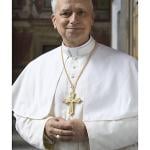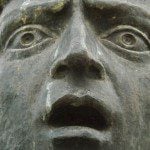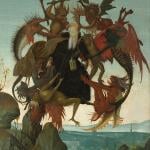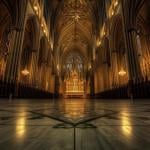IN THE MIRROR OF MAYA DEREN: It was cool to see “In the Mirror of Maya Deren” reviewed on NRO. Deren was an avant-garde filmmaker; I’ve seen some of her work (can’t remember if it was “Meshes of the Afternoon” or just the excerpts of it in the documentary “ITMOMD”) and wasn’t much of a fan, but her book Divine Horsemen: The Living Gods of Haiti is really excellent. It lays out the basic structure of Vodoun (voodoo), describing the loa (gods, basically), rituals, and overarching worldview. The loa are pretty amazing–I find them more evocative and insight-provoking than the Greek pantheon. That may be in part because of the elements of Catholicism that Vodoun borrowed/misread; or maybe not. Here are descriptions of some loa written several years ago by a friend:
Erzulie is the Loa of Love, the “Lady of Luxury.” But she is not corrupt wealth but a rejection of the limits of poverty. She gives her love as freely as the gifts she gives those she favors. It is as limitless as her wealth. There is no end to her kissing and caressing handsome and charming men. Her endless love links her to the virgin Mary although Erzulie is hardly chaste. She wears three wedding bands. One for Damballah, the serpent. One for Agwe, who rules the sea. One for Ogoun, the warrior. She is also wedded to countless serviteurs. Despite this and the attention lavished on her she feels as though she is not loved enough. …Her rage and despair are as fierce as her love.
Ghede is the embodiment of the inevitable. He is beyond death. After God, we are in the hands of Ghede. He is erotic in the undeniable way everyone is but he differs in that he flaunts it. He is clownish about everything as he is about sex always showing people what they know is true but wanted not to see. Sometimes he is wildly flamboyant, sometimes sly and coy. He can be a tease or he can be unabashedly bawdy. Inhibitions do not stand a chance when faced with this trickster. Once, under the regime of president Borno, a crowd of houngans (priests, sort of) possessed by Ghede marched through the streets dancing and singing. Having attracted a crowd, they all danced up to the presidential palace and, dressed in Ghede’s top hat and coattails, demanded money of the president. The president soon surrendered the cash as no one can refuse Ghede; he will not bow to them. They sing this song for him:
Papa Ghede bel garcon
Ghede Nimbo bel garcon
He is dressed all in black
He is going to the palace
Ghede protects children and they are the primary celebrants on his “feast day” which falls on Halloween. He wears tinted glasses with only one lens so he may watch the physical world with one eye and watch the universe with the other.
Damballah is the head loa, the source of power. He is not really father to the other loa but they call him papa. He must be reverently approached even by the loa because he alone can permit them to answer the prayers and sacrifices of servitors. …The snake is his servant and has a special place on his altar. He is a creator and worship of him is worship of natural beauty. Sacrifice to him is rich and lush.
Ayida Wedo is Damballah’s wife. The arch they form over the world is half his snake half her rainbow. They together are creation, sexual totality. The egg is their symbol and an offering to Damballah….
——————-
back to Eve: The last chapter of DH:TLGOH is the most striking. It’s called “The White Darkness,” and it describes Deren’s own experience of possession by a loa. Deren entered into the worldview of Vodoun so completely–& to her own surprise and dismay–that I was startled to read Potemra’s statement, “Some of the most remarkable material covers her visits — totaling about 21 months — to Haiti, where she studied the practice and theology of voodoo; as part of her investigations, she was ordained a priestess herself.
“Lest this suggest that she was reaching the further end of crankery, the film points out that she named her cat after one of the gods of the voodoo pantheon; and — as one of the film’s commentators notes — this would have been an unthinkable act of impiety for any literalistic voodoo believer. Deren’s was a sophisticated effort at transcendence, of the kind that mythologist Joseph Campbell would later popularize. (Indeed, Campbell was an adviser to Deren on the book she wrote summarizing her Haitian research.)”
Not sure what the deal is there. DH certainly didn’t seem to be presenting this distinction between the cool, sophisticated, all-cultures-converge type and the “literalistic voodoo believer”; I thought its point was more an affirmation of both the convergence-of-cultures thing (which I don’t buy) and the reality of Vodoun loa and the worth of Vodoun practices (with which I also disagree!).
How do I approach Vodoun as a Christian? Well, I don’t “believe in” it, for one thing. I find the loa evocative but I do not think that they are in fact gods; it is wrong to sacrifice to them or entreat them. Vodoun is a striking work of art, but it doesn’t really explain the world well. It is like the Greek pantheon (or, for that matter, the Platonic theory of forms), in that philosophical questing would, I think, lead you up and out of it toward the One God. As far as I know there is no real account of wrongdoing, the human tendency toward evil, or how to mediate conflicts between values (like justice/mercy, custom/questioning, pride/love). This is in no way unique to Vodoun; it seems to me to be an inherent tendency or lack in pantheon-based, syncretistic religions. The response to conflict is to borrow, compartmentalize (we conflict because you follow Ogoun and I follow Erzulie), and value multiplicity, rather than seeking reconciliation and harmony. One of the central Christian metaphors is marriage, the kiss that unites two spouses–“righteousness and peace shall kiss each other.” The Vodoun metaphor is more like the multiple wedding rings Erzulie wears. And this leads to a deeply anti-philosophical tendency to shrug and say, “You have your way, I have mine.” (Good grief, that’s an incredibly compressed paragraph.)
What, then, are the loa? I think I have to say that they are some combination of fictional characters/mythic archetypes, and real aspects of the world (personifying and allegorizing beauty, power, and other attributes of God). And possession? I would suggest as one possibility that most cases of Vodoun possession are what you might call a culturally-inflected, self-induced trance. Some cases may also be the work of demons, especially in the areas of Vodoun that exalt cruelty, despair, and pride. (As with many pantheon-based religions, followers/serviteurs of different loa exalt different things, some much closer to God than others.) (Oh, and if you wig out when I talk demons, would you wig when I talk about angels? Why are the nice angels so much more acceptable in our public discourse than the wicked ones? I do not think Catholics can deny that there are indeed “evil spirits that roam through the world seeking the ruin of souls.” But I don’t think they [demons, not Catholics!] need the romanticized, exoticized trappings of Vodoun to work their ill.)











